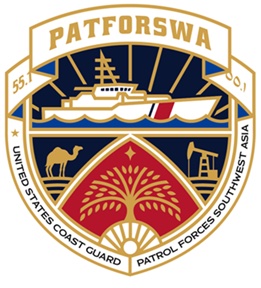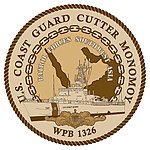
The Island-class patrol boat is a class of cutters of the United States Coast Guard. 49 cutters of the class were built, of which 7 remain in commission. Their hull numbers are WPB-1301 through WPB-1349.
The history of the United States Coast Guard goes back to the United States Revenue Cutter Service, which was founded on 4 August 1790 as part of the Department of the Treasury. The Revenue Cutter Service and the United States Life-Saving Service were merged to become the Coast Guard per 14 U.S.C. § 1 which states: "The Coast Guard as established January 28, 1915, shall be a military service and a branch of the armed forces of the United States at all times." In 1939, the United States Lighthouse Service was merged into the Coast Guard. The Coast Guard itself was moved to the Department of Transportation in 1967, and on 1 March 2003 it became part of the Department of Homeland Security. However, under 14 U.S.C. § 3 as amended by section 211 of the Coast Guard and Maritime Transportation Act of 2006, upon the declaration of war and when Congress so directs in the declaration, or when the President directs, the Coast Guard operates as a service in the Department of the Navy.

The Ukrainian patrol vessel Sloviansk (P190) was an Island-class patrol boat of the Naval Forces of the Armed Forces of Ukraine. Originally named USCGC Cushing when in service with the United States Coast Guard, the vessel was acquired by Ukraine in 2018 and arrived in Ukraine on 21 October 2019. Sloviansk was sunk in combat on 3 March 2022 by a Russian air-to-surface missile.

United States Coast Guard Station Woods Hole is a United States Coast Guard station located in Woods Hole, Massachusetts. The station is home to Sector Southeast New England.

Patrol Forces Southwest Asia (PATFORSWA) is a United States Coast Guard command based in Manama, Bahrain. PATFORSWA was created in November 2002 as a contingency operation to support the U.S. Navy with patrol boats. The command's mission is to train, equip, deploy and support combat-ready Coast Guard forces conducting operations in support of Operation Iraqi Freedom (OIF), Operation Enduring Freedom (OEF) and Operation Inherent Resolve (OIR) in the Naval Forces Central Command's area of responsibility. It was commissioned as a permanent duty station in June 2004. In July 2003 PATFORSWA moved from its own compound to facilities at Naval Support Activity Bahrain.

USCGC Point Comfort (WPB-82317) was an 82-foot (25 m) Point class cutter constructed at the Coast Guard Yard at Curtis Bay, Maryland in 1961 for use as a law enforcement and search and rescue patrol boat. Since the Coast Guard policy in 1961 was not to name cutters under 100-foot (30 m) in length, it was designated as WPB-82317 when commissioned and acquired the name Point Comfort in January 1964 when the Coast Guard started naming all cutters longer than 65-foot (20 m).
USCGC Point Banks (WPB-82327) was an 82-foot (25 m) Point-class cutter constructed at the Coast Guard Yard at Curtis Bay, Maryland in 1961 for use as a law enforcement and search and rescue patrol boat by the United States Coast Guard. Since the Coast Guard policy in 1961 was not to name cutters under 100 feet (30 m) in length it was designated as WPB-82327 when commissioned and acquired the name Point Banks in January 1964 when the Coast Guard started naming all cutters longer than 65-foot (20 m).
USCGC Point Clear (WPB-82315) was an 82-foot (25 m) Point class cutter constructed at the Coast Guard Yard at Curtis Bay, Maryland in 1961 for use as a law enforcement and search and rescue patrol boat. Since the Coast Guard policy in 1960 was not to name cutters under 100 feet (30 m) in length, it was designated as WPB-82315 when commissioned and acquired the name Point Clear in January 1964 when the Coast Guard started naming all cutters longer than 65 feet (20 m).
USCGC Point Garnet (WPB-82310) was an 82-foot (25 m) Point class cutter constructed at the Coast Guard Yard at Curtis Bay, Maryland in 1961 for use as a law enforcement and search and rescue patrol boat. Since the Coast Guard policy in 1961 was not to name cutters under 100-foot (30 m) in length, it was designated as WPB-82310 when commissioned and acquired the name Point Garnet in January 1964 when the Coast Guard started naming all cutters longer than 65-foot (20 m).
USCGC Point Glover (WPB-82307) was an 82-foot (25 m) Point class cutter constructed at the Coast Guard Yard at Curtis Bay, Maryland in 1960 for use as a law enforcement and search and rescue patrol boat. Since the Coast Guard policy in 1960 was not to name cutters under 100 feet (30 m) in length, it was designated as WPB-82307 when commissioned and acquired the name Point Glover in January 1964 when the Coast Guard started naming all cutters longer than 65 feet (20 m).
USCGC Point Grey (WPB-82324) was an 82-foot (25 m) Point class cutter constructed at the Coast Guard Yard at Curtis Bay, Maryland in 1961 for use as a law enforcement and search and rescue patrol boat. Since the Coast Guard policy in 1961 was not to name cutters under 100 feet (30 m) in length, it was designated as WPB-82324 when commissioned and acquired the name Point Grey in January 1964 when the Coast Guard started naming all cutters longer than 65 feet (20 m).

USCGC Point Mast (WPB-82316) was an 82-foot (25 m) Point class cutter constructed at the Coast Guard Yard at Curtis Bay, Maryland in 1961 for use as a law enforcement and search and rescue patrol boat. Since the Coast Guard policy in 1961 was not to name cutters under 100 feet (30 m) in length, it was designated as WPB-82316 when commissioned and acquired the name Point Mast in January 1964 when the Coast Guard started naming all cutters longer than 65 feet (20 m).

USCGC Adak (WPB-1333) was a United States Coast Guard cutter that received her name from Adak Island in the Aleutian Islands of Alaska. Built at Bollinger Shipyard in Lockport, Louisiana, Adak was placed in commission on 18 August 1989 in New Jersey and decommissioned on 30 June 2021 in Manama, Bahrain after almost 32 years of service.

USCGC Point Marone (WPB-82331) was an 82-foot (25 m) Point class cutter constructed at the Coast Guard Yard at Curtis Bay, Maryland in 1962 for use as a law enforcement and search and rescue patrol boat. Since the Coast Guard policy in 1962 was not to name cutters under 100 feet (30 m) in length, it was designated as WPB-82331 when commissioned and acquired the name Point Marone in January 1964 when the Coast Guard started naming all cutters longer than 65 feet (20 m).

USCGC Point Young (WPB-82303) was an 82-foot (25 m) Point class cutter constructed at the Coast Guard Yard at Curtis Bay, Maryland in 1960 for use as a law enforcement and search and rescue patrol boat. Since the Coast Guard policy in 1960 was not to name cutters under 100 feet (30 m) in length, it was designated as WPB-82303 when commissioned and acquired the name Point Young in January 1964 when the Coast Guard started naming all cutters longer than 65 feet (20 m).
USCGC Point Dume (WPB-82325) was an 82-foot (25 m) Point class cutter constructed at the Coast Guard Yard at Curtis Bay, Maryland in 1961 for use as a law enforcement and search and rescue patrol boat. Since the Coast Guard policy in 1961 was not to name cutters under 100 feet (30 m) in length, it was designated as WPB-82325 when commissioned and acquired the name Point Dume in January 1964 when the Coast Guard started naming all cutters longer than 65-foot (20 m).

USCGC Point Orient (WPB-82319) was an 82-foot (25 m) Point class cutter constructed at the Coast Guard Yard at Curtis Bay, Maryland in 1961 for use as a law enforcement and search and rescue patrol boat. Since the Coast Guard policy in 1961 was not to name cutters under 100 feet (30 m) in length, it was designated as WPB-82319 when commissioned and acquired the name Point Orient in January 1964 when the Coast Guard started naming all cutters longer than 65-foot (20 m).
USCGC Point Cypress (WPB-82326) was an 82-foot (25 m) Point-class cutter constructed at the Coast Guard Yard at Curtis Bay, Maryland in 1961 for use as a law enforcement and search and rescue patrol boat. Since the Coast Guard policy in 1961 was not to name cutters under 100-foot (30 m) in length, it was designated as WPB-82326 when commissioned and acquired the name Point Cypress in January 1964 when the Coast Guard started naming all cutters longer than 65-foot (20 m).

USCGC Point White (WPB-82308) was an 82-foot (25 m) Point class cutter constructed at the Coast Guard Yard at Curtis Bay, Maryland in 1961 for use as a law enforcement and search and rescue patrol boat. Since the Coast Guard policy in 1961 was not to name cutters under 100 feet (30 m) in length, it was designated as WPB-82308 when commissioned and acquired the name Point White in January 1964 when the Coast Guard started naming all cutters longer than 65 feet (20 m).

USCGC Maui (WPB-1304) was a United States Coast Guard Island-class patrol boat homeported in Manama, Bahrain. She was named after the second-largest of the Hawaiian Islands, Maui.













